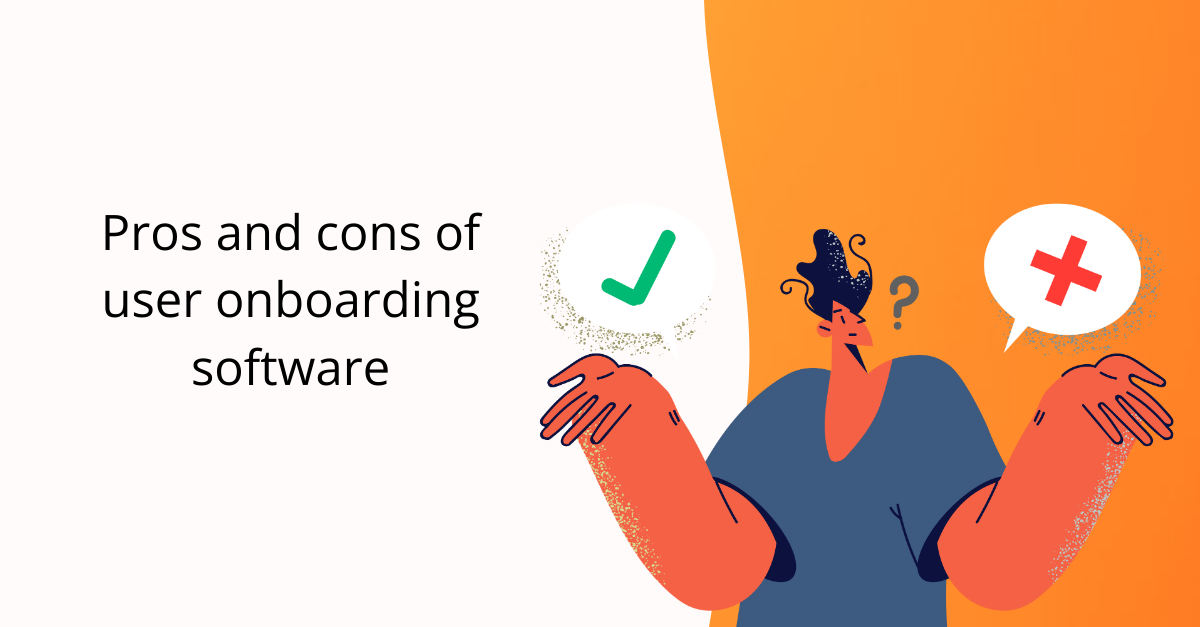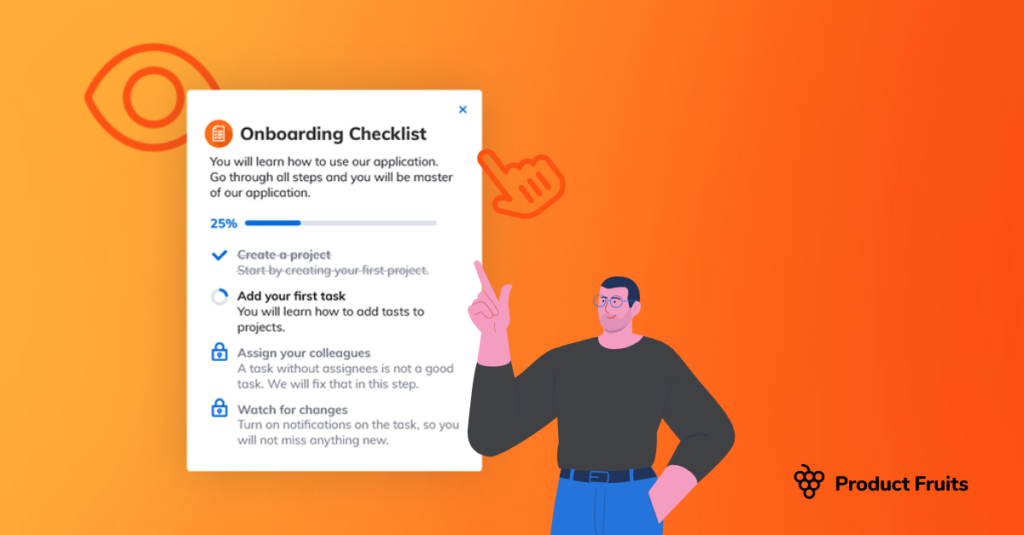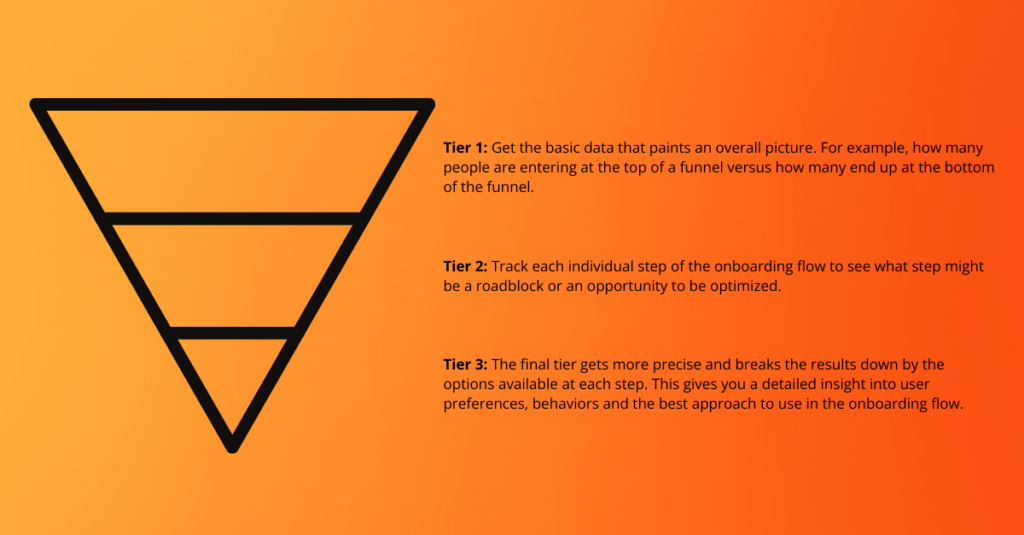
This article is a collaboration between Product Fruits and Flow Agency
It almost goes without saying that the most important part of your onboarding experience is your strategy. But it’s an important reminder that you need one.
Your onboarding strategy is the reason “why” you choose one tactic over another, or why you highlight one feature over another.
Sadly, you can’t magically create the perfect strategy. But you can make important steps in the right direction starting today.
It requires some research, a good understanding of your product or platform and its market position, a good understanding of your users, and a lot of learning.
When I start an onboarding project, I also turn to ‘best practices’. They’re an essential part of my process, helping to guide and shape things when nothing seems clear.
Instead of getting caught up in a never-ending cycle of “what should I do first”, and “we don’t have the time to conduct a huge research project”, or “a strategy would be great, but who’s going to create it?”, I look at what we know…
What do we know so far about our product, results, users, etc.? What are the industry benchmarks? What are our competitors doing? What feels like a good user experience based on what we do know (and all of the above)?
Understanding these best practices will be hugely beneficial in helping us to create a user onboarding strategy to increase activation, conversion, retention, and on-going user satisfaction.
I’m Jamie, and I’ve spent the last 14+ years working with technology and SaaS platforms, from founder-led SaaS hatchlings all the way up to companies listed on the stock exchange – I’ve seen it all.
My love for SaaS and all things ‘onboarding’ related has never faltered, and a couple of years ago I decided to go at it alone and start Flow, a dedicated user onboarding agency that works with all types of SaaS and product-based companies to positively impact the way they do, think and understand onboarding and product-led growth.

When it comes to your onboarding goals, your strategy is your North Star.
Now, the word “strategy” can conjure up some pretty daunting thoughts, and you may be thinking “but we don’t have the time or resources to dedicate to this”, but I assure you that you can make a lot of progress with small but meaningful steps.
I always recommend three things: starting small, starting somewhere, and working backwards.
Working backwards allows you to reverse engineer a goal, for example, “what do our users need to accomplish with our platform?”, or “what would a moment of real value look like for our users?”, or “how can we show our users that our platform can solve their challenges and pain points?”.
By working backwards from your goal, you create the “why” behind every decision you make, along with a reason for every touchpoint in the user journey.
Your onboarding strategy helps you to define that North Star, and ultimately come up with digestible steps that take your users through a journey with relevant touch points and onwards to achieving their goals.
When creating your user onboarding strategy, here are some steps that I recommend taking that will help you get a solid foundation in place quickly and efficiently.
Start with the user’s end goal. That moment, also known as the “aha moment” is where users realize the value of your platform.
This moment should be the focus of your onboarding flow — getting users to perceive value as fast as possible.
Now, there can be multiple end goals for your users, and these could even be different for different user types and segments, but for the purpose of this exercise (and generally for getting started) I recommend starting with one.
Choosing a goal to focus on can be tricky but if there’s one that affects the largest number of users, or makes the most sense to begin with for whatever reason, that’s a great starting point.
Note: The way that we like to work at Flow is we conduct some initial market, user and competitor research, and then run a Jobs To Be Done (JTBD) exercise to identify 2-3 key JTBD statements. These statements then become our focus when it comes to building out an onboarding strategy and subsequent tactics, but for the purpose of this article, I’m going to keep things simple.
Working backwards from a goal has been my own “aha” moment in my career. As simple as it may sound, reverse engineering a process and mapping out the steps has changed the way I think about user experiences. It’s allowed me to make sense of user journeys in a way I couldn’t when trying to start at point A and end at point Z.
Another powerful benefit of ‘working backwards’ is that it allows you to more easily remove unnecessary steps, and any ‘fluff’, only focusing on the essential steps and touchpoints.
Now, your platform likely has many moving parts, and building a strategy around everything can be hard. But this is where the focused goal comes into play.
By focusing only on that one goal – at least to begin with – you’re giving yourself permission to ignore everything else for the time being.
For example, one of my client’s has a platform where the user’s main goal is to save time when creating Instagram posts in-line with a larger content strategy. So, a moment of value for every user is to show them how quickly (and easily) they can create a post with a few clicks.
By knowing this goal, we were able to hone in and push users towards creating their post within a matter of seconds – and completing the post within their first minute – drastically increasing activation and reducing adoption time.
Whenever we start a new project at Flow, we always craft an onboarding checklist.
A checklist is a clear outline of the steps a user must take in order to realize value within your platform. It’s often a user-facing list, just like Product Fruits checklists, but it can also be an internal list – if you’re not ready to launch a checklist in your platform, or you decide against it for any reason, I still recommend having an internal checklist.
An exercise we do at Flow is we identify the goals we want a user to achieve and we map those out, noting the key steps along the way. This could be inviting a team member, updating their user profile, or even successfully utilizing a feature within your platform.
Internal checklists are a handy tool to make sure you’ve covered all areas of your platform in-line with the goal you’re trying to get each user to achieve. Once you feel happy that it’s ready, you can launch it for your users to help guide them through the onboarding process.

Your goal needs the right metrics and KPIs in order for them to be relevant and helpful in improving user onboarding.
For example, if you’re struggling with activation, then you’re looking for metrics like:
*Credit to Hotjar for these calculation recommendations.
👀 Check out our guide to 6 User Onboarding Metrics You Need to Keep An Eye On
Your data depends on if it’s activation, upsell subscription, or if it’s churn prevention. Those goals should govern those sets of data, and then ultimately, you want to be knowing how your onboarding is driving success or failure.
Further to the activation and feature adoption rates mentioned above, I also recommend taking a three-tiered approach to your onboarding data and event tracking:

For example, take a registration form. If a user logs into a platform to create an account, that could be the top of a funnel (Tier 1). Then, they fill out a registration form (Tier 2), and on that form they reveal they’re part of a marketing team of ten people (Tier 3).
That gives you three different tiers of data to work from when creating a strategy.
There’s a million and one ways to onboard users, and the reality is, each user will have their own preferences. Some users will need to be guided continuously. Others will prefer to learn at their own pace with contextual onboarding elements.
There’s infinite ways. And yes, that can be intimidating.
But this also presents a lot of opportunities.
Each user, goal, user case will have a preferred approach. The goal of a strategy is to tie them all together.
With an onboarding strategy, you can make sure all elements, content, and flows lead to the right user goal. There is going to be a persona A who loves reading documentation, or a persona B who wants email, and then you have persona C who wants to live-chat with someone.
Each touch point needs to be considered within the overall strategy.

But, an important reminder: you can’t start with everything. Start somewhere and work your way towards implementing more touch points and more tracking to analyze the success of each touch point. Don’t be afraid to ignore things now in favor of getting started and making important steps towards your own internal ‘aha’ moments.
👀 Curious about user personas? Take a peek at our guide: Experts explain the role of user segmentation during onboarding
A company that managed to meet users where they were at is Keboola. Keboola, a data analytics platform, known to be feature-rich, can be intimidating to a beginner.
Although each user has the same goals, their experience level with data and the platform varied greatly. This meant that some users required more help compared to others.
To tackle the difference in data and platform knowledge, Keboola created three different demos for each user level (beginner, intermediate, and experienced). This allowed for users to gradually appreciate all the features they offered and create their own projects without feeling overwhelmed.
This strategy to match users led to an increase in conversion and 70% less repetitive support tasks for the team.
Read the full case study here: How Keboola accelerated its user onboarding by 29%
Once you’ve created an onboarding flow that guides a user towards the goal in question, you can begin to think about adding personalization and ‘micro-moments’.
A micro-moment is a touchpoint or personalization within the onboarding journey that helps push users towards the ultimate goal – and their ‘aha’ moment.
These allow you to target users with content and experiences they wouldn’t expect. A great example of this is Loom. When onboarding new users, they ask what their role is. This allows them to add a personalized note of value about how each team uses Loom. In this case, for marketing, Loom share their product is often used to promote new features.
(Source: Loom)
You can also target users with personalized and hyper-relevant content such as helpful pop-ups, tool-tips, or recommendations that help them get the most out of their experience.
For example, when onboarding with Miro, you are asked what your role is in a company. This allows the company to come up with helpful tips and advice on how to use Miro especially catered to that role, including templates with pre-populated content and sections.
Data can also be used to understand where these personalization and micro-moment opportunities are. You can trigger experiences based on what the user has, or hasn’t done, or their preferences.
First impressions count. It’s essential to make a great first impression with new users and get them well on their way to realizing value as quickly and efficiently as possible.
Successful onboarding not only increases the likelihood of paid subscriptions, but it directly impacts churn:
Successful onboarding = value realization > higher satisfaction > lower churn
By following the five steps outlined above, you’ll be well on your way to creating an effective onboarding strategy that moves the needle across all of your key business goals, including activation, subscription, and retention.
I’m always keen to talk about all things ‘onboarding’, so if you’d like to chat, or have an onboarding problem you’re trying to solve, feel free to reach out to me here or via the Flow website.
And if you’re looking for a tool to enable your onboarding strategy, which gives you all the features and analytics to give life to your strategy, then schedule a demo with one of our onboarding specialists, we’ll show you what Product Fruits offers.